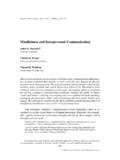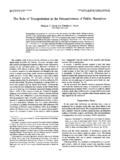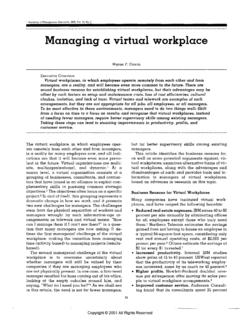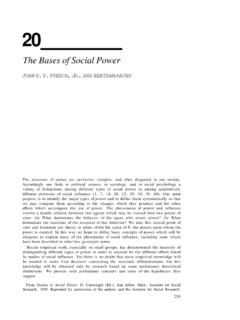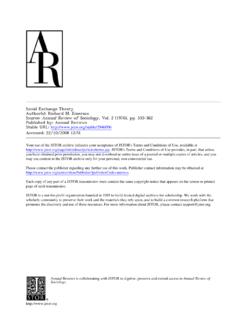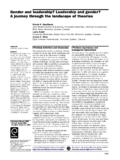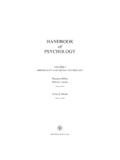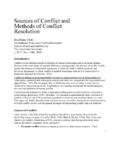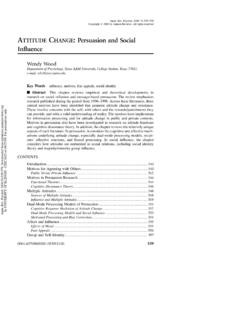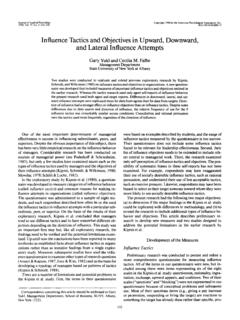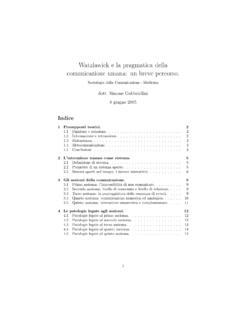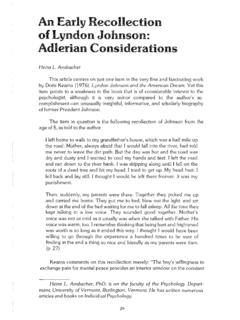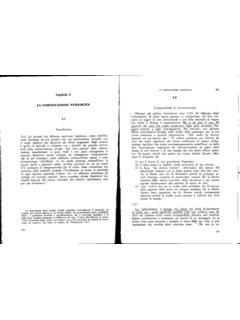Transcription of RESISTANCE TO CHANGE: THE REST OF THE STORY
1 RESISTANCE TO CHANGE: THE rest OF THE STORYJEFFREY D. FORDThe Ohio State UniversityLAURIE W. FORDC ritical Path ConsultantsANGELO D AMELIOThe Vanto GroupPrevailing views of RESISTANCE to change tell a one-sided STORY that favors changeagents by proposing that RESISTANCE is an irrational and dysfunctional reaction lo-cated over there in change recipients. We tell the rest of the STORY by proposing thatchange agents contribute to the occurrence of RESISTANCE through their own actionsand inactions and that RESISTANCE can be a resource for change .
2 We conclude byproposing how RESISTANCE might be is time to expand our understanding of re-sistance to change , including its sources and itspotential contribution to effective change man-agement. As others have noted (Dent & Gold-berg, 1999a; King & Anderson, 1995; Meston &King, 1996), the predominant perspective on re-sistance is decidedly one sided, in favor ofchange agents and their ofchange appear to take the perspective, or bias,of those seeking to bring about change , in whichit is presumed change agents are doing the rightand proper things while change recipientsthrow up unreasonable obstacles or barriers in-tent on doing in or screwing up the change (Dent & Goldberg, 1999a.)
3 Klein, 1976). Accord-ingly, change agents are portrayed as undeserv-ing victims of the irrational and dysfunctionalresponses of change change agent centric view presumesthat RESISTANCE is an accurate report by unbi-ased observers ( change agents) of an objectivereality ( RESISTANCE by change recipients). change agents are not portrayed as partici-pants who enact their environments (Weick,1979) or construct their realities (Berger & Luck-mann, 1966) but, rather, as people who deal withand address the objectively real RESISTANCE ofchange recipients.
4 There is no considerationgiven to the possibility that RESISTANCE is aninterpretation assigned by change agents to thebehaviors and communications of change recip-ients, or that these interpretations are eitherself-serving or , for that matter, does the change agent centric view consider the possibility that changeagents contribute to the occurrence of what theycall resistant behaviors and communications through their own actions and inactions, owingto their own ignorance, incompetence, or mis-management ( , Beer, Eisenstat, & Spector,1990; Kanter et al.)
5 , 1992; Schaffer & Thompson,1992; Spreitzer & Quinn, 1996). Rather, resistanceis portrayed as an unwarranted and detrimentalresponse residing completely over there, inthem (the change recipients) and arising spon-taneously as a reaction to change , independentof the interactions and relationships betweenthe change agents and recipients (Dent & Gold-berg, 1999a; Ford, Ford, & McNamara, 2002; King& Anderson, 1995).We thank Abhishek Haldar and the anonymousAMRre-viewers for their invaluable assistance in the developmentof this the purpose of exposition, we use the termchangeagentto refer to those who are responsible for identifyingthe need for change , creating a vision and specifying adesired outcome, and then making it happen.
6 They are thepeople responsible for the formulation and implementationof the change and include what Kanter, Stein, and Jick (1992)call change strategists and implementers. change agents,therefore, include those engaged in the actual conduct of thechange, as well as those who call for and sponsor it. We usethe termchange recipientsto represent those people whoare responsible for implementing, adopting, or adapting tothe change (s) (Kanter et al., 1992). Academy of Management Review2008, Vol. 33, No. 2, 362 of the Academy of Management, all rights reserved.
7 Contents may not be copied, emailed, posted to a listserv, or otherwise transmitted without the copyrightholder s express written permission. Users may print, download, or email articles for individual use to organization change is neverportrayed as the product of rationally coherentstrategies and objectives (Jermier, Knights, &Nord, 1994), even though RESISTANCE to persua-sion has been found to be the product ofthoughtful consideration ( , Knowles & Linn,2004b; Wegener, Petty, Smoak, & Fabrigar, 2004).Nor is RESISTANCE to change viewed as a poten-tial contributor to or resource for effectivechange, despite the fact that authentic dissenthas been shown to be functional in other areasof management (Nemeth, Brown, & Rogers, 2001;Nemeth, Connell, Rogers, & Brown, 2001; Schulz-Hardt, Jochims, & Frey, 2002).
8 As a result, wehave a one-sided view of RESISTANCE that istreated as received truth, even though this viewis both theoretically and practically limited,overly simplistic, and perhaps even misguided(Dent & Goldberg, 1999b; Jermier et al., 1994;King & Anderson, 1995).Given these limitations, we think it is time toexpand the RESISTANCE STORY in three ways: first,by considering RESISTANCE as a self-serving andpotentially self-fulfilling label, given by changeagents attempting to make sense of change re-cipients reactions to change initiatives, ratherthan a literal description of an objective reality.
9 Second, by examining the ways in which changeagents contribute to the occurrence of the veryreactions they label as RESISTANCE through theirown actions and inactions, such as the breach ofagreements and failure to restore trust (Cobb,Wooten, & Folger, 1995; Folger & Skarlicki, 1999;Morrison & Robinson, 1997; Tomlinson, Dineen,& Lewicki, 2004), which implies that RESISTANCE isneither a sudden nor a direct response to a par-ticular instance of change but, rather, a functionof the quality of the relationship between agentsand recipients in which change agents are andhave been active participants and contributors;and, third, by considering that there are circum-stances under which what agents call resis-tance can be a positive contribution to change ( , Knowles & Linn, 2004c).
10 By assuming thatresistance is necessarily bad, change agentshave missed its potential contributions of in-creasing the likelihood of successful implemen-tation, helping build awareness and momentumfor change , and eliminating unnecessary, im-practical, or counterproductive elements in thedesign or conduct of the change are not the first to reexamine RESISTANCE orits role in organizational change . Others havequestioned its continued usefulness (Dent &Goldberg, 1999a; King & Anderson, 1995), pro-posed conceptual reformulations ( , Piderit,2000), or challenged its theoretical underpin-nings (Czarniawska & Sevon, 1996; Latour, 1986).
